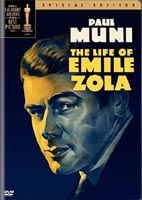 BUY IT AT AMAZON: CLICK HERE!
BUY IT AT AMAZON: CLICK HERE!
STUDIO: Warner Bros./First National Pictures
MSRP: $19.97 RATED: NR
RUNNING TIME: 116 Minutes
SPECIAL FEATURES:
• 03 Vintage Vault Treasures: “The Littlest Diplomat” (dramatic short), “Romance Road” (musical short), and “Ain’t We Got Fun” (Merrie Melody cartoon short)
• Audio-Only Bonus: 05.08.39 Lux Radio Theater Production starring Paul Muni, narrated by Leslie Howard
• Original Theatrical Trailer
The seeds were planted, in script form, and sprouted in the hands of a genius. Ernst Lubitsch, famed for his literate and hilariously involving films (especially To Be Or Not To Be), was placed in charge of The Life of Emile Zola during his tenure behind the famous Bronson gate(s). Realizing that he couldn’t do the film justice, it curiously found its way over to the Warner Lot, a studio synonymous with bringing gritty, lifelike, common-man stories to the realism starved theatergoers. There, it fell into the hands of Paul Muni, already well versed in the craft of screen biographies (having been Louis Pasteur in The Story of Louis Pasteur), who coincidentally, was Lubistch’s first choice for the part. In essence, a small inkling of the immortal question of ‘What Would Lubitsch Do?’, one that haunted Billy Wilder for years upon years, has had more heat thrown into its cinematic fire.
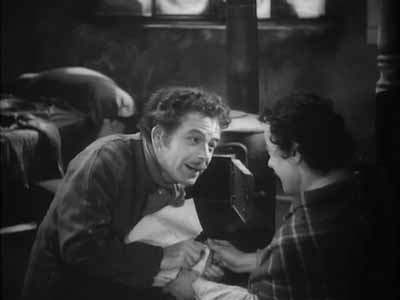
The roaring question presents itself: can a solitary man fight to right a terrible injustice? Is it worth everything you have to continue your ideals of civil liberties, even if that means going against a well-oiled bureaucratic machine? Director William Dieterle and actor Paul Muni attempt to answer these questions with their award-winning biographical film. Before I begin, it would be best to note that liberties were taken in the making of this film. Massive ones. Examples abound everywhere, but it is paramount to the understanding of the cinematic life of Emile Zola that these liberties were to serve the narrative, to allow for greater flexibility. Certain people have had their religious preferences stricken (Capt. Dreyfus’ identity being the most glaring omission), so if a viewer were to have the assumption that this film were sticking to the facts of the history already lived, they might be somewhat disappointed in the direction the film veers. I wasn’t, and rightfully so. The Life of Emile Zola is an spectacular film, filled with powerful performances and the answer to questions posed about the life of one single, solitary man, sticking up for what he believes in.
The Flick
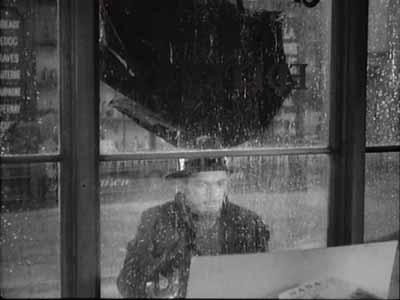
been had… for the 10th consecutive time today.
Paris. 1862. Two struggling artists, one of words, and the other, of images, huddle close to their ideals as the cold outside rushes into their tiny dilapidated attic (one that would be right at home in NYC). Emile Zola (played heroically by veteran thespian Paul Muni) proceeds to board up the holes in their rickety windows with paper. A necessity for him, considering he has a natural aversion to drafts. His roommate and lifelong friend Paul Cézanne (Vladimir Sokoloff) scoffs at this impromptu decision, but nonetheless goes along. They seem to have always enjoyed arguing back and forth, and relishing giving way to the ideas and thoughts that spring from their plight. Fate intervenes when Zola’s mother stops by, informing Emile about a grand job opportunity she has acquired for him, he’s to be a clerk at a book publisher. Excited at this grand turn of events, Zola sees this as a way out, a way to pay bills, and of course, a way to live, hopefully to see his writing flourish on the side. Cézanne is happy for his friend as well, although this surely signifies the end of his character in regards to the narrative, if only for a little while.
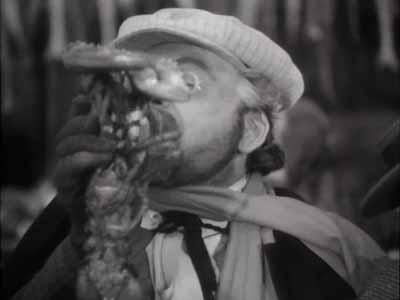
It at his place of employment where we learn more of the real Zola, if only glimpses were caught in his tiny living space, in his working environment, he’s a real rebel-rouser. Constantly on the defensive, he criticizes everything he sees as unjust and unfair, from the butcher’s indignation and flat out refusal of his credit, the arts, fellow writers (especially the reporting of the news), even the men running his beloved France. He’s given the ultimatum by a superior, either shape up, stick with keeping in line or be extremely sorry of the consequences. He quits on the spot. Continuing to write, he retains his inquisitive nature, his listening capabilities, and his overall warm, young, and idealistic disposition (some might call it stubbornness, but in reality, these are his basic ideals forming), even if it means this lone man must ruffle more than a few feathers to get his point across.
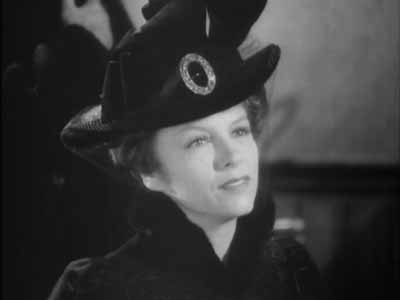
Late one night at a café, Zola and Cézanne meet a lovely woman of the streets, and one can only guess at what profession she inhabits (the film merely hints at this, although she is also subsequently involved with the police, sparking her refuge into the café). She shares a small moment with Zola and Cézanne, but it is in this moment where the character of Monsieur Emile Zola really starts to shine. All of his redeeming qualities are laid out onto the cinematic table for the audience to judge him by, and granted, we’re not even twenty minutes into the film, and as such, not even remotely close to the main piece of the entire film. Fortunately, it is here where the finishing touches of Zola’s nature are on display. While listening to this woman, Nana, it is clear that Zola is indeed inquisitive, very warm, caring, listening, and above all thoughtful of his fellow man/woman. He listens. He’s thinking. He studies her. All the while, Zola is content with not speaking one word. It is within Muni’s great capabilities as an actor where he doesn’t allow this to become heavy-handed with emotional resonance, you feel that he IS this character, and this is naturally what he MUST do. This encounter has such a profound impact on him, the end result is his first novel: NANA. Being, of course, about the seedy underbelly of Paris, the one most writers of that day were shying away from, pulls no punches. It soon becomes the talk of the town. Zola is now on his way to financial success.
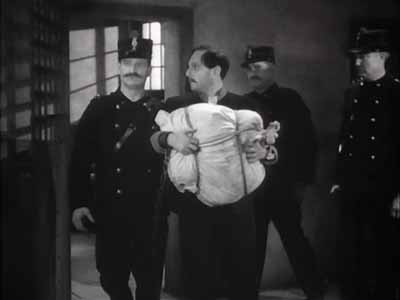
This paves the way to Downfall, which is Zola’s indictment against the French Army, after its long and drawn-out war with Prussia. He waxes poetic against "the mismanaged war", creating waves of controversy in the process. He’s subsequently made more than a few enemies over in the department of the Army, especially the Generals running the place. They consider his words slander, a moral outrage. I’m reminded of the scene in David Lean’s Lawrence of Arabia where the chief inspector studies the disarray and utter lack of necessities of the Turks’ so-called ‘hospital’ in Damascus. The look on his face is the look on the General’s face when they speak of Zola. Locking into disgust and hatred on the printed words. These are men who can’t take criticism in any shape or form. They have a fine tuned machine in their old boys club, and they don’t want any outsiders poking in to tell them their business. Emile is soon called up against the Chief Censor of France, while this time, appearing a little older and a little grayer. Zola will neither yield nor back down, as it is his duty to tell the country of how he feels about his world around him, everything is fair game. He will continue to write, to fight for things he believes are unjust.
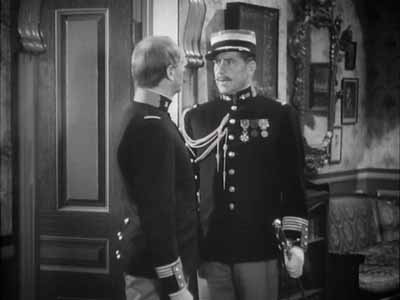
Zola writes many more novels, visually implied rather bluntly and blandly, while he’s now older, speckled white-gray, and supremely experienced in the ways of life. Cézanne is back over for a hearty meal, and the friends recall their old adventures with much gusto, particularly their fondness for breaking the rules and having fun at it. In this course of events, the film’s director Dieterle and Muni inject such complex humanity into the visual performances, and you can sense in their eyes as much as their sometime distant body language. Dieterle takes his time in setting up this massive plot point, because it is the catalyst into which Zola will change, thinking back on this meeting of minds. In other words, Zola’s success has transformed him into the lazy, carefree, successful writer he so dreaded to become in the past. Taken aback, the friends amicably part ways, their friendship seemingly at a crossroads, one that could be salvaged, if Zola wasn’t so damned headstrong. During this unfortunate incident, across town, Major Walsin-Esterhazy (the shadowy figure Robert Barrat) is scribbling some extremely top-secret details furiously in a very important letter for his secret contact at the German embassy. The filmmakers make no subtleties in revealing who this traitor is; they want you to identify with Zola’s fight for injustice later on, so this forthcoming choice of visual presentation is a necessity. The only problem being that it never gets to its destination, and is intercepted by French agents, spying against the Prussians. This letter makes its way into the hands of the Generals, who again, are furiously outraged. You can almost sense their moustaches will fly off from all of the pouting they’re accomplishing on screen, but such isn’t the solution to their problem of whom to blame for this highly treasonable offense. Quick thinking is to blame. Only someone like an officer would know of its minute details, the placement of guns, the amounts of troops, very treasonable items contained in the infamous letter.
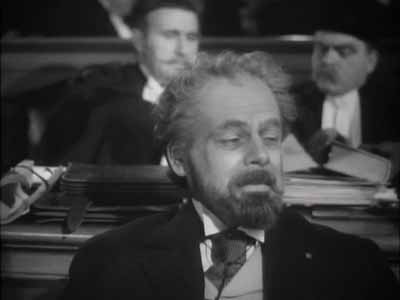
Hastily scanning the lists of officers, they settle and agree upon one name. Alfred Dreyfus (played by Best Supporting Actor winner Joseph Schildkraut). In their flawed reasoning (one that is very vague, although history knows this was a massive case of anti-Semitism, one that isn’t ever mentioned in this film), they can’t seem to tell the forest from the trees, if only for that instant. Their choice is made, and stone mountains of suspect and revenge are now in its immovable place. Captain Dreyfus is a well-to-do family man, with a seemingly ideal life. He’s so under the spell of happiness and trust that he refuses to believe anything but his summons being for a general inspection, rather than for an arrest on the acts of treason. Illegal searches and seizures follow, as do accusations flying from all sides, and finally a sentencing that is justly unfair. Zola, at this point, has remained rather relatively ambivalent to the pomp and circumstance surrounding the whole outrage in France. "A traitor’s a traitor" he comments, somewhat shrugging the whole thing off without even bothering to realize the facts. Therein lies the moment of realization, that Zola has reneged on his principals, his self-fulfilling fear has manifested itself into his psyche, and he’s content with it. But not quite, as Madame Lucie Dreyfus pleads her case to Zola as several years pass (two or so in cinematic screen time, through those not-so subtle titles), and finally, Zola takes heed of what he’s learned those many months before after an impassioned outburst by Mme. Lucie. Onward and upward, he sets out to free Capt. Dreyfus from the corrupt confines of his Devil’s Island prison cell and he fires his first shot with a (now legendary historical) scathing article against the Army addressed directly to the President of the Republic. Setting his pen to paper he writes: J’Accuse (or simply: I Accuse!).
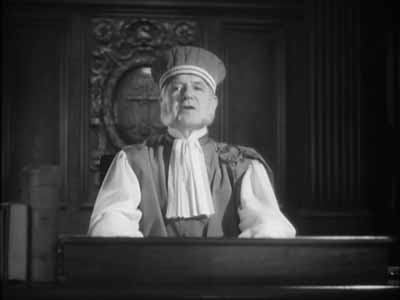
The Life of Emile Zola‘s main centerpiece is the fight to right injustice. It is what Zola has been attempting to do on a much smaller printed scale for those many years previous. This is one of the granddaddies of social injustice films, in part because of the relative age of the film (almost 68 years old!), and in part of the formula the movie establishes (man learns he must, man goes against knowledge, injustice occurs, man then steps up against it), on top of the social constructs from which it has sprung out of. The seeds of this premiere argument are sown all throughout the film, but ultimately, it is how the film is told that is so enthralling on the grandest scale. This movie is very intimate, as it should be to feel and understand who Zola is. You can feel this sense of intimacy throughout its confines in cafes, bookstores, Zola’s house, Dreyfus’ prison cell, the General’s headquarters, even in the cramped attic. It is only in those instances of grand undertakings where the film grows beyond its enclosed borders and ventures to provide a larger canvas of interaction, especially in the sweeping courtroom sequences, the Army ceremonies/accusations, and at the end of the film. All of these instances are where director William Dieterle shines the brightest, in many respects, because he is truly one with the material. He’s never show-offy, but restrained. He never presents anything as bigger than it truly is. You never get the feeling he’s attempting to cram righteousness down your throat. He presents the faux underdog-esque moments as they are, and they’re up to you to decide. His ease and steadiness of the intensely enthralling courtroom sequences are as interesting to study as they are to behold. While the spectators are arguing and yelling with one another, he stages the action up front, and occasionally has one solider come down to berate the man on the stand. It creates such an interesting scene because of its relative chaos. In addition to this, Dieterle subtly, and most assuredly, with the help of Muni, presents Zola almost as if he were a conductor in the courtroom scenes of personal strife. His actions are purely fluid and precise, and it could almost be timed in scale to the words he’s using against his accusers. Nonetheless, these instances are excitement and great filmmaking at its early talking best.
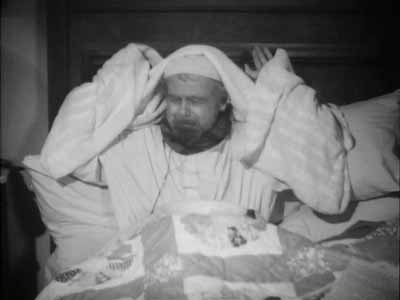
However, in all of my praise, this is completely and utterly Paul Muni’s film. He permeates every level of the film, and in all of those scenes without Zola, he makes you think of him and only him. He’s the glue that holds each piece of spliced film together. He is the essence of this film, the man driven to do good at all costs. Muni’s Oscar winning Zola may have slightly changed, but he’s still a powerful figure, one filled with thoughtfulness, desire, and respect for his fellow man. This is a man who might be silent most of the time, listening, thinking, respecting, and observing, but when he speaks he lets himself be known to all. "We must work by pen, by speech, by action!" he happily declares. I cannot think of a better way to fully understand his characters actions, Zola’s ways of thought. Aside from his towering performance in I Am A Fugitive From A Chain Gang (a masterpiece in the best sense), Emile Zola is one of his greatest roles, one that was rewarded accordingly, and I treasured every moment with his conscience and desire to make right from wrong in every conceivable instance.
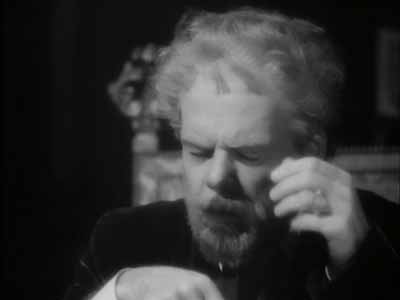
The musical score was lushly and exquisitely provided by the versatile Max Steiner, who has written some of the most famous film scores ever (and if you don’t know, just check out his resume of credits somewhere else). While not at his best here, Steiner has nevertheless crafted and concocted a fitting score here to underline most of the action on screen. He even goes so far as to throw in bits of La Marseille, hidden somewhat in those haunting variations of the theme on redemption, desire, and towering personal accomplishment. All in all, this is an adequate score that clicks with the material and gives the audience the much-needed aural backgrounds during the times of Zola’s life. Finally, the cinematography of Tony Gaudio (who helped paint The Adventures of Robin Hood, one of the most beautiful Technicolor movies ever made) works spectacularly in every black & white locale, emphasizing the mood over plot and tension over harrowing sequences of personal doubt and triumphant success. I’m reminded of the several scenes outside, in addition to the amazingly complicated crane shots that crane in and out to give us an intense visual scope of each scene. His job was simply stunning, and he’s greatly added depth and meaning to The Life of Emile Zola‘s visuals.
So, in the end, The Life of Emile Zola scores a…
9.0 out of 10.0
The Look
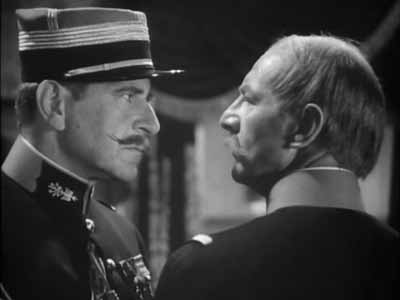
This is an adequate transfer, but my one gripe is that occasionally, there appeared to be a small pulsating light effect in the middle of the frame (almost as if the projector bulb were whirring about, overtaking the image subtly). This could account for the film to DVD transfer, in the way it was threaded through the machine, or possibly because the only best surviving print of the film is somewhat diminished. This is a great film, filled with interesting imagery, and the blacks and whites are used in a way to add great emphasis to the right moments, except for that effect I could be looking too deeply into. If the film was cleaned up for its digital bow, I commend the team behind this one, as it appears to have taken a lot of work, and it is exactly how I expected it might look.
8.0 out of 10
The Noise
Presented in its original Mono soundtrack, this has been updated and backed by the good people at the WB and Dolby Digital. I have absolutely no complaints. Crisp and clear, with the occasional film ‘popping’ and ‘crinkling’ sounds (I admit that I love these sounds and it wouldn’t be an older movie without them to me), it’s wondrous to imagine that these mighty wavelengths have survived this long, and that the whole film sounds as good as it does.
9.0 out of 10
The Goodies
Billed as a Special Edition, on top of an Academy Award Winner, Zola is severely lacking in the elements that have previously graced other SE’s of Warner Best Picture winners (such as Treasure of the Sierra Madre, Around the World in 80 Days, Giant, and even their recent grand-slam WB Gangsters Boxed Set). I was surprised that for such an important film for Warner Brothers (their first Best Picture winner), the world (being a bonafide box office smash), and for the home viewer (mostly likely being their first introduction to the film), that more material wasn’t included to help understand why the film was made and what steps everyone took to see that this film turned out the way it did. I would have even settled for some sort of a documentary depicting its legacy (again, the Gangsters set does this spectacularly), rather than the condensed Lux Theater Program of the film. I truly hope this film isn’t forgotten in some respects (although it might be), because it is a great one, and I am saddened that it didn’t come with more features that support and place this amazing film on its correct pedestal. However, on this single disc set there are:
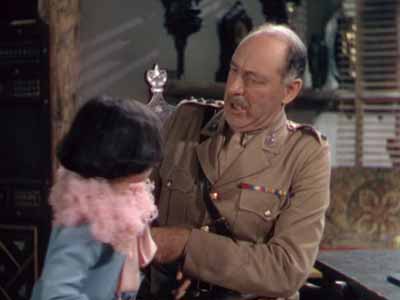
Short Film: "The Littlest Diplomat" (run time: 19:06). A Technicolor short w/ Sybil Jason and Lumsden Hare (such a great name). In the vein of such adventurous films as Gunga Din (minus the imperialism and outright star wattage), this comedic short revolves around a Colonel whose motto is "bullets and bayonets are the solution to one’s problems". He belongs to the sacred necessity of the fighting forces, one where orders and regulations are what continually makes a man happy, wealthy, and wise. While he is at odds with The Kahn on the border of Afghanistan (in reality this short is on a soundstage, and you almost can tell, which ultimately makes it even more endearing), his granddaughter decides to pop by for a little visit. In the process she decides she wants to be an Army officer and promptly goes about messing everything up in the close-knit garrison. Songs are sung, bugles are blown that accidentally signal the call to arms, and finally she’s reprimanded for all of her trouble. Undaunted, and very headstrong, she escapes, and is caught by the Colonel’s mortal enemy The Kahn, only to enlighten him of their differences between his tribe and her grandfather’s garrison. You can see where this is going all the way from the moment she escapes, but all in all this is a fun little short that has absolutely no slow moments, pierced with an appropriate wall-to-wall comedic, light, and very easy to hear score, along with a real innocent earnest quality that will have you smiling or rolling your eyes depending on your film watching sensibilities.
The Look: 8.5 out of 10
The Noise: 9.0 out of 10
Overall: 8.8 out of 10
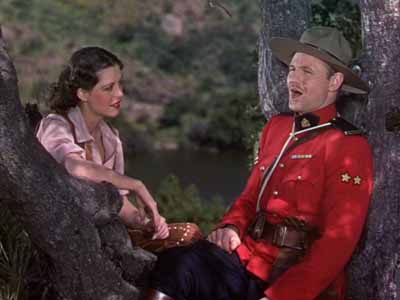
talking ’bout Hoes, yeah, uh huh, uh huh, yeah boyeeee!"
Musical Short Film: "Romance Road" (run time: 18:45). Yet another Technicolor short, this time with the Royal Canadian Mounted Police! They ride roughshod, they’re incredibly husky, and above all, they’re manly men singing their hearts content. Sample lyrics: "to keep the peace, we’ve gotta police!" (or as I misheard them the first time: "to keep the peace, we mount the police!"). Anyway, Sergeant Shane Rollins, a poor man’s Sterling Hayden, complete with hat, horse, and moose friends, must fight the trappers threatening the livelihood of the railroad, those loveable TNT toting industrialists, who just want to bring a little modernization into everyone’s lives. Throw in some Native Canadian-Americans and a love interest, one that has quite the flirting eye for our Sergeant Rollins, and you’ve got a short filled with action (fist fights galore!), suspense (what is going to happen with the woman on the cliff?), singing (some catchy tunes), and romance (there is a lot of doe-eyed people staring lovingly back and forth). However, I felt like they were trying to cram a bit too much into this short, and at times, its schizophrenic nature flies by and leaves you wondering why a particular choice was made, as in there being absolutely no character development. Everyone is either a cutout or a cliché (and trust me, flannel wardrobes are all over every frame). So, I’m mildly conflicted, but it’s still fun nonetheless.
The Look: 9.5 out of 10 (this is where the short really shines, it looks spectacularly terrific!)
The Noise: 9.0 out of 10
Overall: 6.5 out of 10
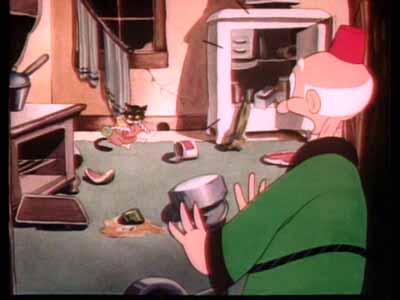
Cartoon Short: "Ain’t We Got Fun" (run time: 08:23). This WB Merrie Melody is presented in a very faded primary color scheme (I believe this would have to do with the age of the short and the surviving elements), permeating every frame, and could have something to do with its age. In a sleepy covered town, an Old Man lives with his Cat. The two are about to go to sleep when out come the Mice, ready to play. When the Cat’s asleep the Mice will eat their way into house and home, and they cause some intensive havoc. The Cat finds out, but mistaken identities are at fault when the Old Man throws the Cat out into the snow. Meanwhile, the Mice are content with the change of events and set about eating and being merry, all the while singing the title of the short. You’ve heard the song before, I suppose. It’s a classic. So, will the Old Man find out in time? Will the Cat save the day? Watch it to find out. This is a quick comedic and lovely short film, one that is extremely washed out and somewhat faded in retrospect, but it works pleasantly in the end.
The Look: 5.0 out of 10
The Noise: 7.0 out of 10
Overall: 7.0 out of 10
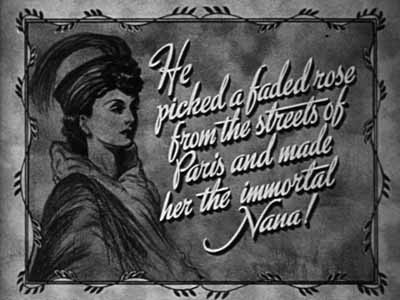
The Life of Emile Zola Original Theatrical Trailer (run time: 04:19). The trailer starts off stressing the films greatness and critical praise, visually represented by various magazines (included are The New Yorker, Time, McCalls, Esquire, Screen Daily, Life, etc.), while it switches to a scene with him and Nana. The following is then shown: Zola exposes corruption, Zola expounding against the Army (before the idea of Downfall), Dreyfus being placed under arrest, TITLE CARD (on newspaper): "I ACCUSE!", Dreyfus’ condemnation scene, "let’s get Zola!" mob of pedestrians scene, and the TITLE CARD: A REBEL GENUIS NEVER TAMED! Stream of consciousness imagery round-up aside, this is a wonderful presentational trailer for those interested, and I was captivated by its quick editing, crisp, clean, and spotless video quality, and rather emotional moments. Consider me sold.
The Look: 9.0 out of 10.0
The Noise: 9.0 out of 10.0
Overall: 9.0 out of 10.0
Audio-Only Bonus: 05.08.39 Lux Radio Theater Production of The Life of Emile Zola starring Paul Muni and narrated by Leslie Howard (run time: 58:28, 12 chapters). This audio-only Special Feature is a more brief, condensed aural version of the exact same thing you’ve (most likely) watched visually. Personally, Muni’s voice is great and extremely theatrical, but I’d prefer to actually see this as well, and that comes from a modern lifetime of imagery flashing from sunrise to sunset. I believe it would pack more punch if I had grown up around Radios and widescreen’s historical introduction, but this is a little distilled with today’s modern technologies. Leslie Howard, fresh off of a break in filming Gone With The Wind, aids in narrating, thus tying up some of the visual aspects of the film into his narration. He subsequently adds a level of British respectability into the verbal proceedings. This, along with the theatrical trailer, are the only Special Features remotely related to the production of WB’s Oscar Winner, and although I love the fact they added this, it still doesn’t feel as a cohesive whole to the rest of the materials included as it needs to be.
The Noise: 10 out of 10
Overall: 8.0 out of 10
7.0 out of 10
The Artwork
I like it because it is simple. It tells you of the star of the film, in his darkly covered lighting scheme, and thus hints into the psyche of his character, in his desire to find the truth (light) in everyday injustices (dark) through the way it is presented. I also enjoy the way Muni is almost painted in a cubist-like stroke of hard lines, stark contrasting colors, and a life-like intensive stare. This is a very exquisite cover, one that I think succeeds and works tremendously well for what in this day and age is considered a tough sell.
9.5 out of 10